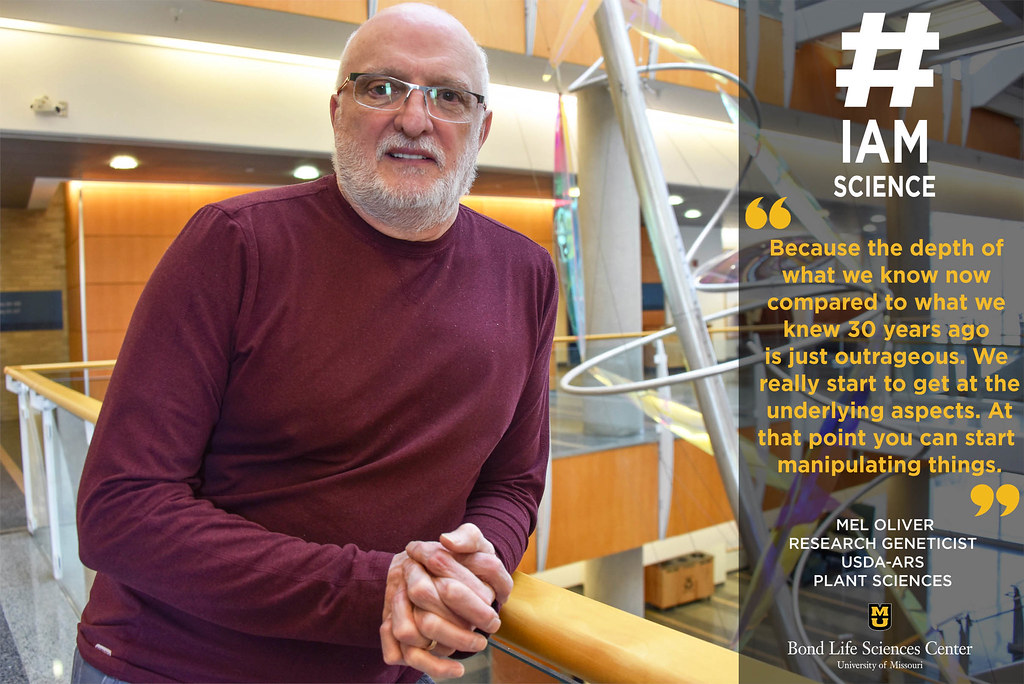
By Lauren Hines | Bond LSC
With his wide range of teas laid out along the windowsill, and his small posters still in stacks on the floor, Mel Oliver is still setting up his new office at Bond LSC after arriving in December.
It takes a while to settle into a new space like the office on the south side of Bond LSC’s third floor, especially after spending 30 years in a job like the one he held with the US Department of Agriculture until he retired late last year. On most days, he types away at his computer writing his papers and sits back to think whilst playing with his wedding ring, but even with 40 years of discovery under his belt, Oliver isn’t quite done with his search for answers.
Oliver grew up just north of London — which you can hear in his lingering accent — and received his undergraduate degree from the University of East London. After he earned his master’s and Ph.D. in Calgary Alberta, Canada, he came to St. Louis to work with a top plant molecular biologist. He met his wife of 34 years in St. Louis and after living in New Mexico and Texas, he returned to Missouri.
Oliver was a graduate student in Calgary when he found his calling in plant sciences.
“I was interested in all sorts of different things in plants, and the Ph.D. supervisor I started working for put a piece of [dried] moss in my hand and squirted water on it, and it [came back to life].” Oliver said. “I was hooked.”
Oliver gained an interest in desiccation tolerance — the ability of certain plants to dry completely and then fully recover once water was introduced again.
At a meeting in California, Oliver’s Ph.D. supervisor was talking and kept mentioning Oliver’s work in desiccation tolerance. At that same meeting, there were United States Department of Agriculture recruiters looking for a molecular scientist who understood plant stress.
At 39 years old, Oliver was recruited by USDA and has worked for them for the past 30 years.
“It was good to work for them, but it’s a different thing than university in the sense that we have a more practical leaning than does a university researcher,” Oliver said. “So, you’re trying to work towards a more agricultural goal to improve U.S. farming, whereas here you’re interested in that, but you’re also more focused on scientific questions and that’s the difference.”
Even though Oliver retired from the USDA on Nov. 30, he still has two grants that he’s working on — one with a group of MU researchers led by Robert Sharp and is collaborating with Bond LSC researcher Ruthie Angelovici — so moving into Bond LSC seemed like a logical next step.
“I didn’t want to stay where I was in Curtis [Hall] because then I’m so close to where I’ve been for the last 15 years,” Oliver said. “I didn’t feel like there’s been any change.”
One of his grants focuses on plant metabolomics and the effect of drought on nodal root growth in maize, where he collaborates with Robert Sharp, director of MU’s Interdisciplinary Plant Group. The other grant, Oliver’s self-proclaimed “claim to fame,” is on desiccation tolerance and is part of a large multidisciplinary effort. He has been also working with Angelovici on aspects of desiccation tolerance in grasses.
For the past 40 years, Oliver has been trying to figure out how these “resurrection plants” can be completely drained of water and then come back to life. This pursuit of knowledge has all been in an effort to figure out how people can make plants more tolerant of drought.
“We now understand a lot more about how resurrection plants work. So, we have a much better understanding of how these plants deal with desiccation on a metabolic level,” Oliver said. “I’ve been involved in sequencing many genomes of resurrection plants as well as the mosses and that’s given us insights that we’ve never had before.”
In his research, Oliver studies these plants through their genomes and gene expression.
“I think the thing we’ve confirmed more than anything — the ability to survive drying is a very ancient trait,” Oliver said. “There’s no real evidence for it, but genomes are indicating that it’s probably the origin of land plants depended on desiccation tolerance.”
As part of the plant sciences division, Walter Gassmann — interim director for Bond LSC — worked with Oliver in coordinating the 2015 IPG symposium at Bond LSC.
“I think his work is really fascinating,” said Gassmann. “He doesn’t limit himself to the easy things. Some of these plants are not standard experimental systems, so you have to build techniques and learn how to work with them, so he’s been very pioneering in his work.”
After these two grants are finished, Oliver will officially retire and put up his lab coat.
“I don’t think any scientist is ever ready to leave it…” Oliver said. “You have to hope what you’ve written and what you’ve said in meetings has inspired someone younger to go that route. And there are! Our field, in the last 10 years, has boomed in the number of people getting into looking at resurrection plants because of the impact of global warming. Everybody’s interested in how plants that survive in very extreme environments can survive and how do they do that and what can we learn from that? That’s what drove me and that’s what’s driving young people now.”

